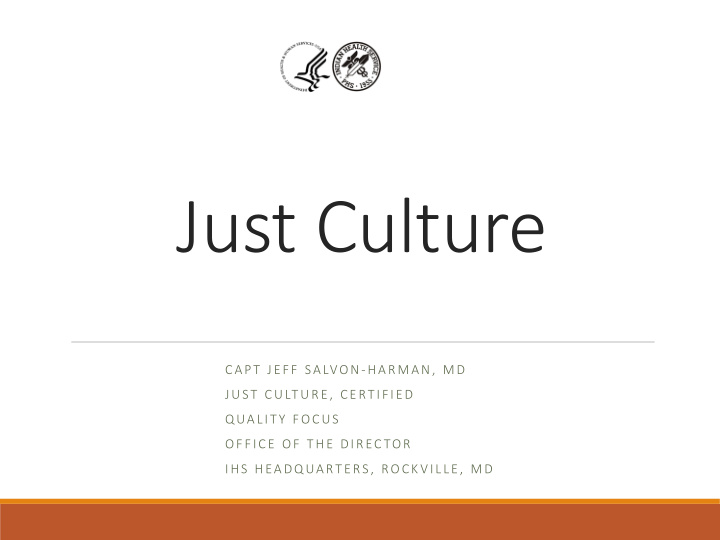



Just Culture CAPT JEFF SALVON-HARMAN, MD JUST CULTURE, CERTIFIED QUALITY FOCUS OFFICE OF THE DIRECTOR IHS HEADQUARTERS, ROCKVILLE, MD
Just Culture? Is this just a culture issue? • “Just” - as in “Justice” • Just defined: • Based on or behaving according to what is morally right • and fair What does a Just Culture look like? •
Three Manageable Behaviors 1. Human Error • Entirely unintentional 2. At-Risk Behavior • Aware of risk, though believed to be insignificant or justified 3. Reckless Behavior • Conscious disregard of substantial and unjustifiable risk
Three Behaviors - Human Error We all make mistakes • Slips and lapses • Free of intention (inadvertent actions) • Examples: • Spilling coffee/juice while reading the newspaper • Look-alike/sound-alike medications •
Three Behaviors - At-Risk Accepting a known risk for overriding reasons or lack of • awareness of a known risk Intentional action but unintended outcome • Examples: • Illegible written Rx when EHR is down (rationale: patient • still needs meds) Not using an available checklist to save time before a • procedure (perceived as unnecessary)
Three Behaviors - Reckless Knowingly putting your self or others at risk • Intentional action with probable outcome, though not • desired Examples: • Relying on the EHR for transitions in care rather than • providing a verbal and written warm hand-off Disregarding inaccurate sponge/instrument count in • surgery (self-assured of accuracy)
Just Culture Responses
Applying Just Culture Adverse Events • Managing Systems • Supervising People •
Event Investigation Identify root causes • Apply Human Factors Analysis and Classification System (if • available) Ask “why?” 5 times • Final step: identify Breaches of Duty •
Breaches of Duty 1. Duty to Avoid Causing Unjustifiable Risk or Harm 2. Duty to Follow a Procedural Rule 3. Duty to Produce an Outcome Categories of Breach: A. Insufficient prevention, diagnosis, or treatment of patient disease or condition B. Harm caused incidental to the practice of medicine C. Inappropriate conduct not directly related to the practice of medicine
Breach of Duty – Unjustifiable Risk or Harm Applies to a healthcare provider’s/staff’s actions, in any • situation, that might lead to harm of persons or property. Includes: • A. Not ordering or following an order for an indicated diagnostic test B. Ordering/dispensing/administering a contraindicated prescription C. Disruptive behavior
Breach of Duty – Follow a Procedural Rule Applies when a healthcare provider/staff works within a • system and is responsible for following a procedural rule created by the system. Includes: • A. Failure to use approved order sets B. Not participating in a required pre-procedural time-out C. Not completing documentation according to a procedure
Breach of Duty – Produce an Outcome Applies when a provider/staff is largely in control of the • system by which the outcome is produced. Includes • A. High patient return rate to the Emergency Dept B. High prescription order/dispense/administer error rate C. Violations of time and attendance
Decision Making
Decision Making
Why Change? How do we currently respond to breaches? • Does this impact: • Morale? • Retention? • Recruitment? • Quality? • Safety? •
Benefits of a Just Culture Fair and consistent application of organizational justice • Reduces fear of undue punishment • Increases reporting of events • Leads to increased reporting of risk prior to events • Just Culture is the foundation upon which Safety • Culture is developed
How to get there 10 Step Process 1. Leadership Commitment 2. Build Champion Team 3. Champions Lead Change 4. Update Policies 5. Update Practices 6. Train all Leaders 7. Develop Learning Culture 8. Refine Learning Systems 9. Train All Employees 10. Measure Progress
Summary What a Just Culture looks like • Three Behaviors • Three Duties • Applying Just Culture • Developing a Just Culture • Benefits of a Just Culture •
Conclusion It’s not just a culture, it’s a Just Culture.
Questions? Thank You
Recommend
More recommend